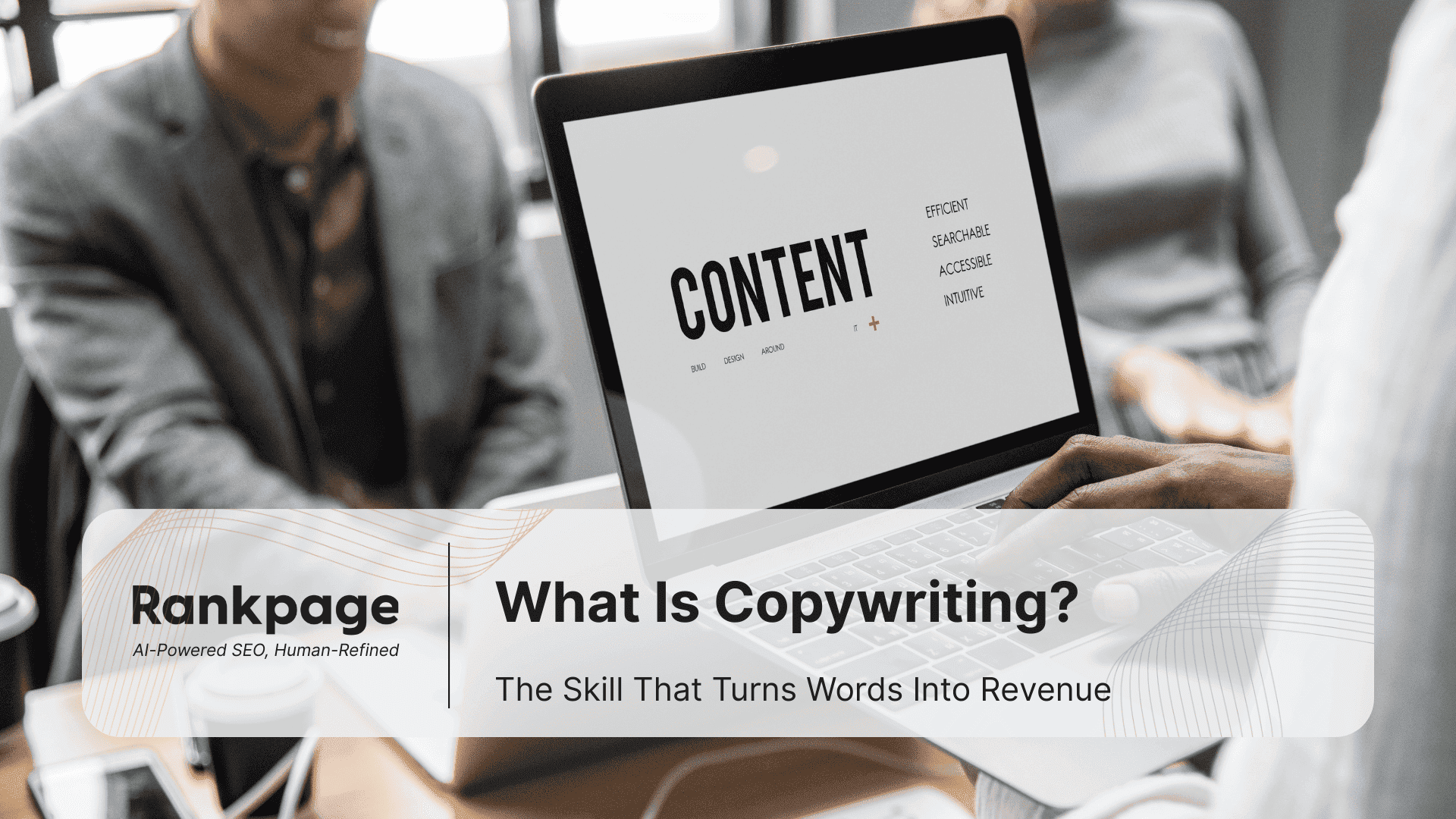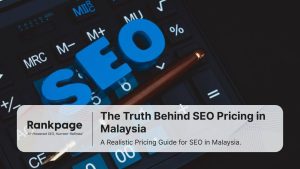Key Takeaways
- Copywriting sells without selling, using persuasive writing to turn readers into paying customers.
- In digital marketing, copywriting drives clicks, leads, and conversions across ads, websites, and social media.
- Strong copywriting aligns with audience psychology, making messages resonate and prompting action.
- It’s measurable and optimisable, allowing marketers to refine content based on engagement and sales data.
- Investing in copywriting boosts ROI, making it one of the most cost-effective digital marketing skills.
Copywriting is the art of writing persuasive text that inspires the reader to take action, whether that’s clicking, buying, or signing up.
If you’ve ever clicked on an ad, opened an email, or bought something because of a single compelling sentence, you’ve seen copywriting in action.
Even the title of this blog is probably what got you clicking, so that’s proof of it!
In today’s fast-moving market, great copywriting is the fuel that powers high-performing campaigns, especially among the sea of AI-generated content.
So strap on in and let’s discover the wonders of copywriting and why it’s a skill, not an afterthought.
Table of Contents
What Is Copywriting in Digital Marketing?
Unlike general content writing, which focuses on informing or entertaining, digital marketing copywriting exists to convert. AKA, turn prospective customers into loyal consumers.
It is used in:
- Ad campaigns (Google Ads, Facebook Ads)
- Website headlines and landing pages
- Email marketing
- Social media posts
- Sales scripts and product descriptions
- Blog post (such as this)
The whole idea is to increase conversion rates through strategic messaging.
“According to Nielsen Norman Group, well-crafted headlines can increase conversion rates by up to 10%.”
Why Copywriting Matters in Digital Marketing
A good copy is the difference between “Oh, that’s nice” and “Shut up and take my money.”
You could have:
- An SEO strategy that dominates search results
- A marketing budget that could buy a small island
- A follower count rivaling your favourite influencer
…but if your words don’t connect, your audience won’t click, buy, or even remember you.
Here’s what great copy actually does for you:
- Boosts ad click-through rates
- Makes social posts worth engaging with (instead of being scrolled past at lightning speed)
- Turns landing pages into lead magnets
- Builds brand authority
Without it, you’re just shouting into the void. With it, you’re starting conversations that lead to conversions.
Types of Copywriting in Digital Marketing
Writing isn’t something as simple as asking ChatGPT to “write a persuasive copy”. It takes skills, intuition and a lot of practice. Here are the types of copywriting you commonly see in marketing:
1. Direct Response Copywriting
Get the reader to take immediate action, buy now, sign up, download, click.
This style is all about urgency and persuasion. You’ll often see it in landing pages, sales letters, and ad campaigns. Every word is there to move the reader closer to the “yes.”
Example: Grab notifications you get on your phones when it’s almost lunch time? That is a Call-to-action asking you to “jimat” and click now.
Ideal For: Flash sales, product launches, high-converting ads.
2. Brand Copywriting
Build a strong emotional connection and brand personality over time.
This one is less about “buy now” and more about making your brand memorable, trustworthy, and relatable. Think storytelling, values, and tone consistency across all touchpoints.
Even memes, for example, can be used to project a personality that feels human and approachable. The humour, choice of words, and cultural references all feed into how people feel about your brand.
Key traits of effective brand copywriting:
- Consistent voice: Whether you’re witty, formal, or bold, keep it steady.
- Emotional resonance: Make people feel something (pride, nostalgia, excitement).
- Memorable phrasing: taglines, slogans, or catchphrases that stick.
Example: Nike’s “Just Do It” isn’t telling you to buy shoes, it’s telling you to embrace ambition. That’s brand copywriting at work. It’s also memorable!
Ideal For: Long-term brand awareness campaigns, “About Us” pages, company mission statements, and even playful social content.
3. SEO Copywriting (our specialty)
Make your content both findable and irresistible.
SEO copywriting is where technical search strategy meets persuasive storytelling. It’s not just about sprinkling keywords into paragraphs and calling it a day. It’s about weaving them in naturally so Google loves you and your readers stick around long enough to convert.
Why it matters:
- Without optimisation, your content risks being invisible in search results.
- Without persuasion, high impressions won’t translate into clicks, leads, or sales.
Important elements of SEO copywriting:
- Keyword integration: Naturally placed in headlines, subheads, and body copy.
- Search intent alignment: Answer the exact question your audience is Googling.
- Readability: Short sentences, clear structure, and skimmable formatting.
- Compelling CTAs: Turn search traffic into tangible results.
Ideal For:
- Blog posts that answer high-traffic questions (like this one)
- Service pages optimised for local or niche searches
- Product descriptions designed to rank and sell
4. Social Media Copywriting
Stop the scroll and spark engagement.
Every post competes with hundreds of others for attention, so your copy needs to be short, punchy, and instantly relevant.
On social platforms, you only have a few seconds, sometimes less to earn that click, like, or share.
Traits of great social copy:
- Hooks first: Open with a question, bold claim, or surprising stat.
- Platform awareness: Tone, length, and style that suit each platform.
- Conversation over broadcast: Encourage comments, shares, and saves.
- Integration with visuals: Copy should amplify, not repeat, what’s in the image/video.
Ideal For:
- Facebook ads and organic posts
- Instagram captions and stories
- LinkedIn thought-leadership posts
- TikTok captions, hooks, and on-screen text
5. Email Copywriting (Newsletter)
Nurture leads, build relationships, and drive conversions.
Email is one of the few marketing channels where you speak directly to your audience without algorithm interference.
A great email copy feels personal, like a conversation with a trusted friend who happens to have the perfect solution to your problem. A bad one would quickly land you in their spam list.
Key traits of great email copy:
- Personalisation: Use names, preferences, and past behaviours.
- Strong subject lines: Get the open before you try to get the click.
- Clear structure: Short paragraphs, bold CTAs, and easy-to-read formatting.
- Value-first approach: Give something useful before asking for action.
Think of each email as part of a bigger story, build anticipation, trust, and a natural progression toward your offer.
Ideal For:
- Newsletters that educate or entertain while keeping you top-of-mind
- Drip campaigns that warm up leads over time
- Re-engagement sequences that bring inactive subscribers back into the fold
“Most successful marketers mix multiple types of copywriting in a single campaign, for example, an SEO-optimised blog post (SEO copywriting) that links to a targeted landing page (direct response) and follows up with a personalised email sequence (email copywriting).” – Rankpage Senior Content Writer.
How to Write Like a Professional Copywriter
Writing like a pro means understanding why certain words work, how to deliver them effectively, and where they’ll have the most impact.
| Skill | How to Apply It Like a Pro |
|---|---|
| Understand Consumer Psychology | Research your audience’s desires, fears, and motivations. Use their language in your copy to create instant connection. |
| Clarity & Brevity | Cut fluff. Keep every sentence purposeful, inform, persuade, or guide. Remove 20% of words after drafting. |
| SEO Principles | Optimise for search without sounding robotic. Use keywords naturally, match search intent, and structure content for readability. |
| Calls-to-Action (CTAs) | Tell readers exactly what to do next with urgency. Test multiple variations for higher conversions. |
| Platform Adaptability | Match tone, style, and format to the platform and audience. Adjust for Instagram, LinkedIn, emails, or landing pages. |
If you are struggling to write authentic, human sounding content, we suggest you:
- Mine customer reviews for real audience language.
- Write for humans first, algorithms second.
- Always read your copy aloud before publishing, if you cringe, your audience will too.
How to Measure Copywriting Success
While we can go on about how important copywriting is, if you can’t measure how your words perform, you’re guessing instead of optimising.
Tracking the right metrics and data lets you see whether your copy is actually converting or just taking up space. (and time)
Metrics to Track
| Metric | What It Tells You | Why It Matters |
|---|---|---|
| Click-Through Rate (CTR) | Percentage of people who click your link after seeing it. | Measures how persuasive your headline and teaser copy are. |
| Conversion Rate | Percentage of visitors who take the desired action (buy, sign up, download). | Shows if your copy convinces people to act. |
| Bounce Rate | Percentage of visitors who leave after viewing one page. | High rates may mean your copy didn’t match expectations or intent. |
| Time on Page | Average time visitors spend reading your content. | Indicates how engaging and relevant your copy is. |
| Return on Ad Spend (ROAS) | Revenue generated per dollar spent on ads. | Links your copy directly to business revenue. |
Always measure copy in context. A low CTR might not be bad if your conversion rate is high, it means fewer people clicked, but those who did were the right ones. Which is great!
Common Copywriting Mistakes to Avoid
Even the best copywriters have off days, but some mistakes will tank your results faster than a 90% off Shopee flash sale.
Here are the biggest blunders to watch out for:
Writing for yourself, not your audience
Your copy isn’t your diary. What you like isn’t always what sells. A copywriter’s goal is to write for an audience they serve and sell to.
Burying the main point
Don’t make people scroll three paragraphs to find out what you’re selling.
If your headline says “Free nasi lemak,” don’t wait till the end to explain it’s only for customers during weekdays before 5PM with an additional purchase of a teh Ice, t&c apply.
Overloading with jargon
Readers want clarity. Leave the “seamlessly integrated” jargon to the corporations and keep your content simple and easy to understand.
Weak or missing CTAs
By far the most common mistake, a weak or non-existent CTA. If you don’t tell people what to do next, they’ll just close the tab without taking a desired action. Remember, your content is here to guide the user, both informatively and transactionally.
Forgetting mobile users
Most people read on their phone while commuting or queuing for food. Keep it short, bold, and scroll-friendly.
Ignoring proof
Claims without evidence are just talk. Add testimonials, stats, or even a before-and-after picture, people love a good “see for yourself” moment.
“Customer testimonials placed alongside more expensive items increased conversion rates 380%”- Power Reviews”
Conclusion: Turning Words Into Revenue
Copywriting remains one of the highest-impact skills in digital marketing and, frankly, criminally underrated. Just because everyone can write doesn’t mean everyone can write to sell.
That’s where we come in. At Rankpage, we don’t just write, we craft SEO-driven, conversion-focused copy that ranks on Google, stands out in AI Overviews, and gets your audience to click, read, and buy.
Whether you need punchy Facebook ad copy, irresistible product descriptions, or landing page headlines that actually convert, our team can help you land that golden opportunity.
You already read this far into the blog, so clearly we got your attention long enough.
Contact us and let Rankpage write the SEO worthy words that move your business forward.
FAQ About Copywriting
What Is Copywriting In Simple Terms?
It’s persuasive writing that encourages the reader to take action, like buying or signing up.
Is Copywriting The Same As Content Writing?
No. Content writing informs or entertains, copywriting aims to convert.
How Does Copywriting Help Digital Marketing?
It boosts engagement, conversions, and brand perception.
Can Anyone Learn Copywriting?
Yes, with practice and understanding of audience psychology.
What’s The Most Important Part Of Copywriting?
Everything. But mainly an attractive hook and clear call-to-action (CTA).
Does SEO matter in copywriting?
Absolutely, SEO copywriting ensures persuasive text is also discoverable in search engines. Chances are, you are reading this because of our fantastic copywriting too.





